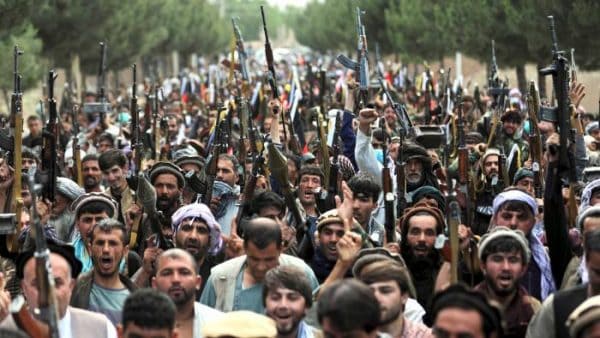The fall of Afghanistan: Blaming Joe Biden is easy, but this has been a long time coming

Triumphant Taliban fighters

On August 14, the Taliban completed its takeover of Afghanistan with the capture of Kabul. To no one's surprise, the group was able to walk into the Afghan capital and take control as President Ashraf Ghani fled. This wasn't a sudden move, for weeks now the Taliban has quickly taken over vast swathes of territory in the war-stricken nation. The fall of Kabul has been blamed squarely on Joe Biden, but just how much is the President actually responsible for?
Frustrated Afghan war veterans have taken to social media to slam Biden, wondering why their friends had to die after the fall of Kabul. It doesn't help that Biden is busy vacationing at Camp David, and is yet to address the Taliban takeover. While one President is on holiday, another has fled entirely. According to reports, Ghani is now hiding either in Tajikistan or Uzbekistan, having surrendered administrative authority to the Taliban.
The fall of Afghanistan is a landmark event, rendering almost 20 years of war moot. Social media was quick to compare it with the fall of Saigon, a landmark moment in the Vietnam war. That led to the end of Gerald Ford's presidency, a historic note that will raise the stakes for Biden. The big question though is if Biden really is to blame for the events in Afghanistan. At first, it may seem so, but if you look carefully, it's a lot more complex than that.
Is Joe Biden to blame?
In part, it is perhaps fair to blame Biden for the Taliban's gains. Biden decided to finally end the occupation of Afghanistan, and American allies swiftly followed. The withdrawal of coalition forces meant the Afghan army was on its own, which as we now know wasn't a great idea. But, if you look at history, you'll see Biden was simply following long-established US policy. While he may have been the first to act, he wasn't the first to call for a drawdown.
In 2011, Obama was the first to announce a troop withdrawal, with a plan to hand over security to the Afghan military by 2014. That timeline was never really met, but Obama nonetheless began removing troops from the country. In 2012, 23,000 American troops left Afghanistan. By the end of Obama's presidency, troop levels had dropped from over 100,000 to 8,400. Trump initially increased numbers to 14,000, before he too began removing them. By October 2019, the Trump presidency saw troop levels drop to 13,000. By the end of Trump's presidency, troop levels were down to just 2,500. Those 2,500 were due to come home by September 11, 2021, under the Biden administration. As the data shows, all three Presidents have played critical roles in withdrawing forces from Afghanistan, not Biden alone.
The dwindling numbers, even slowly, have greatly benefitted the Taliban. Over the years, they have managed to take control of much of rural Afghanistan, leading to the massive offensive in May and June of 2021. Andrew Watkins, the International Crisis Group’s senior analyst for Afghanistan told Vox it's not the troop numbers that were a problem. "The US had several thousand troops to help cover an area of the size of Texas. The US troops were not what was holding the Taliban back in 200 districts around the country. The US troops weren’t even out there at any of those villages." Instead, he believes the lack of air support is to blame. "For most of 2020 and the early months of this year, the US really wasn’t bombing the Taliban. That gave them a major reprieve... The Afghan Air Force can’t close that gap. That means the Taliban had greater freedom to move around the country."
A complex story of war
At the height of the Afghan war in 2010, America had over 100,000 troops in the country. That was just US forces. Keep in mind that allies like the UK, Germany, Australia, Italy, and Canada had also sent troops to Afghanistan. Despite that large number, coalition forces never really managed to beat the Taliban. Over the years, the group has maintained its presence in rural Afghanistan, areas where coalition forces no longer centered their battle plans. Despite being in the country for over two decades, and under four Presidents, the US never actually managed to wipe out the Taliban. It is not a unique story.
Since World War 2, the US has been involved in major combat operations all over the globe. From Iraq to Korea, and Vietnam to Syria, almost all these operations have failed to deliver the decisive victory last seen against imperial Japan and Nazi Germany. The only exception being the Gulf War that led to the capture of Saddam Hussein. Take for example ISIL. In 2019, the US announced it had finally ended the caliphate with the battle of Baghouz, but the reality is far more damning. In the first quarter of 2020, nearly 600 ISIL assaults were recorded in Iraq alone. As of 2021, there are still 2,500 American troops in Iraq and just below 700 in northeast Syria.
What history tells us is that troop numbers alone are insufficient. In the era of internet radicalization and global travel, beating groups like ISIL and the Taliban doesn't just take troops on the ground. Modern war is fought equally amongst the intelligence services, and the administration as it is with boots on the ground. It also requires committed, and capable local partners, which the Afghans clearly haven't been. To that end, the fall of Afghanistan cannot solely be blamed on Biden. It's the failure of US policy for decades, as it is the preparation of Afghan forces to control their country. Even if Biden kept or increased the troops, this result would have seemed inevitable one day, without changes beyond the President's control.
No comments:
Post a Comment